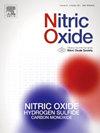一氧化氮的抗菌作用:叙述性综述。
IF 3.2
2区 生物学
Q2 BIOCHEMISTRY & MOLECULAR BIOLOGY
引用次数: 0
摘要
一氧化氮(NO)是一种多功能内源性分子,具有多种生理作用,包括神经传递、血管舒张和免疫调节。作为免疫应答的一部分,NO通过产生活性氮(RNS)发挥抗菌作用。这些RNS通过DNA脱胺、巯基s -亚硝基化和脂质过氧化等机制对抗病原体,导致微生物细胞膜和重要蛋白质功能的破坏。由于这些广泛的作用,一氧化氮靶向许多病原体,包括细菌、真菌和病毒,产生耐药性的风险最小。鉴于其有效的抗菌特性,外源性NO的治疗潜力最近已被研究。各种制剂,如NO供体、吸入气态NO和外用制剂,在临床前和临床环境中显示出有希望的结果。本文综述了体外研究、动物模型和人体临床试验中外源性NO的抗菌作用。我们提供的机制,其中NO发挥其抗菌活性的概述,突出其对多种病原体的功效。通过介绍目前的发现,我们的目标是促进越来越多的证据支持使用一氧化氮作为临床实践中的多功能抗菌剂。本文章由计算机程序翻译,如有差异,请以英文原文为准。
The antimicrobial effects of nitric oxide: A narrative review
Nitric oxide (NO) is a versatile endogenous molecule with multiple physiological roles, including neurotransmission, vasodilation, and immune regulation. As part of the immune response, NO exerts antimicrobial effects by producing reactive nitrogen species (RNS). These RNS combat pathogens via mechanisms such as DNA deamination, S-nitrosylation of thiol groups, and lipid peroxidation, leading to disruptions in microbial cell membranes and vital protein functions. Due to these broad actions, NO targets many pathogens, including bacteria, fungi, and viruses, with minimal risk of resistance development. Given its potent antimicrobial properties, the therapeutic potential of exogenous NO has been recently studied. Various preparations, such as NO donors, inhaled gaseous NO, and topical preparations, have shown promising results in preclinical and clinical settings. This literature review examines the antimicrobial effects of exogenous NO reported in in vitro studies, animal models, and human clinical trials. We provide an overview of the mechanisms by which NO exerts its antimicrobial activity, highlighting its efficacy against diverse pathogens. By presenting the current findings, we aim to contribute to the growing body of evidence supporting the use of NO as a versatile antimicrobial agent in clinical practice.
求助全文
通过发布文献求助,成功后即可免费获取论文全文。
去求助
来源期刊

Nitric oxide : biology and chemistry
生物-生化与分子生物学
CiteScore
7.50
自引率
7.70%
发文量
74
审稿时长
52 days
期刊介绍:
Nitric Oxide includes original research, methodology papers and reviews relating to nitric oxide and other gasotransmitters such as hydrogen sulfide and carbon monoxide. Special emphasis is placed on the biological chemistry, physiology, pharmacology, enzymology and pathological significance of these molecules in human health and disease. The journal also accepts manuscripts relating to plant and microbial studies involving these molecules.
 求助内容:
求助内容: 应助结果提醒方式:
应助结果提醒方式:


